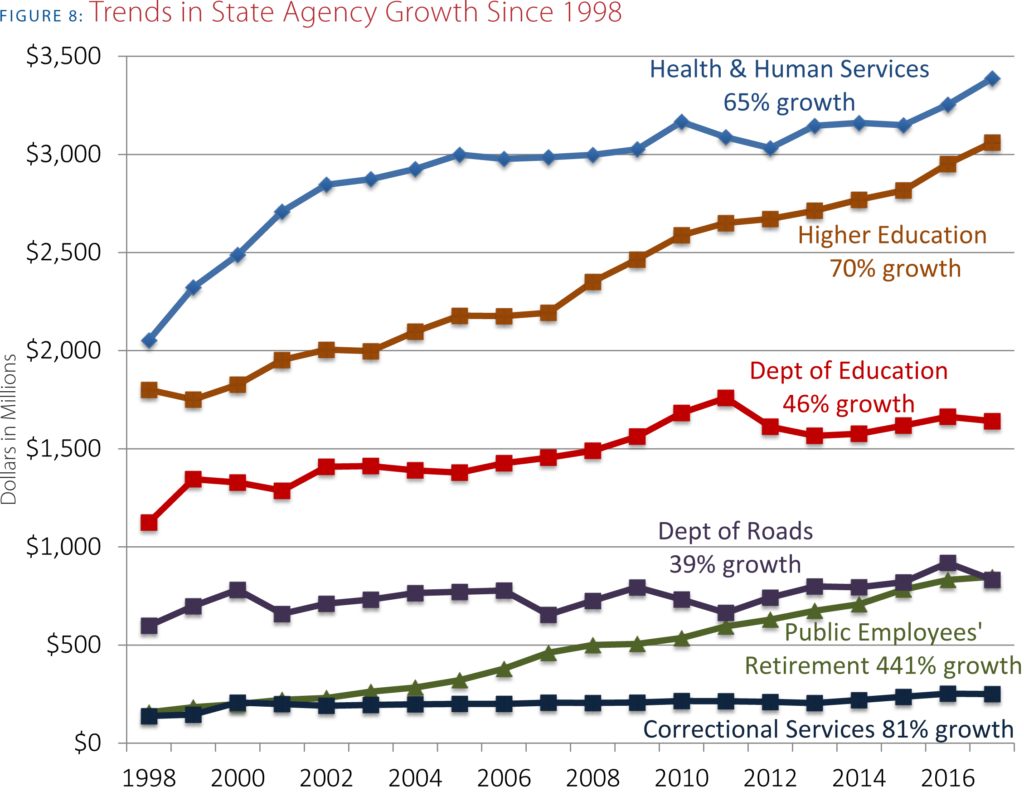What is the fastest growing area in Nebraska’s state budget?
Nebraska’s state budget is growing, but what area of spending is the largest and growing the fastest? Contrary to what many believe, K-12 education is not the largest expenditure in state government. Health and human services and higher education are larger state spending areas, with the state Department of Education coming in behind these two categories.
However, I’m sure you have heard a lot about our state’s prison overcrowding emergency. The media and Legislature have been discussing this for years, and now there is a new poll out by the ACLU of Nebraska with public opinions on prison overcrowding and justice issues.
The press release about their poll cites an OpenSky Policy Institute report that states “growth in state spending on corrections has outpaced growth in other major state funding areas.”
OpenSky is correct about this. But what does this mean when taking the whole budget into account? If corrections spending is growing at a faster pace, is there adequate room for other priorities in the budget, and how much are we actually spending on other services?
You can see all the state agency spending growth in a chart from a Platte Institute report published in 2018 that details the trends in Nebraska’s state spending. While the Department of Correctional Services is technically the state’s operational agency that has the fastest spending growth, the agency that actually has the fastest spending growth is the Nebraska Public Employees Retirement Systems, or NPERS (and yes, they are both considered agencies according to https://www.nebraska.gov/agencies/).

As you can see from the figure above, spending on corrections has grown 81% since 1998. The reason why this fact doesn’t get more attention, though, is because spending areas like health and human services and education are still much larger parts of the budget. So, yes, these areas of spending have grown at a slower pace than corrections when measured as a percentage, but they also dominate most of the dollars in the budget, and as a result, generate more analysis and attention.
Now, look at pensions. There’s no misprint. Over the last 20 years, the Public Employees’ Retirement System has grown at an inflation-adjusted amount of 441%! The state administers five mandatory plans: state, county, schools, judges, and patrol employees. Of these mandatory plans, school employees, judges, and the state patrol are defined benefit plans, which is the main driver of the high cost. State and county employees are cash balance or defined contribution plans.[i]
In fact, if you compare the two fastest-growing areas in the state budget, pensions and corrections, we can see that they were almost equal in cost until a noticeable divergence started in 2002. For those that want to spend more money on corrections – imagine if the two agencies were reversed? Unfortunately, that cannot happen because pensions demand mandatory spending in a way the other agencies cannot. However, it brings up an important discussion of what is causing priorities in the budget to be crowded out. Is it the large spenders like HHS and Education, or is it a faster-growing area like pensions?
This analysis and commentary are not intended to take away from the issue our state is facing with corrections by any means. It is a serious issue that needs to be dealt with from both a spending and policy reform approach. But we need to make sure we understand the whole picture when talking about spending. It could be argued that the larger areas of the budget (HHS, education, and pensions) are crowding out other areas that need attention, like corrections. However, if we ignore the fastest-growing areas of the state’s budget, regardless of how much money they spend, it is likely we will have more problems in the future. Part of fiscal responsibility is looking at the whole budget picture.
[i] Expenditures were taken from Nebraska Annual Budgetary Reports and adjusted for inflation using the St. Louis Fed GDP deflator. Information about the retirement plans was taken from https://npers. ne.gov/SelfService/public/aboutus/aboutus.jsp, accessed June 14, 2018.
